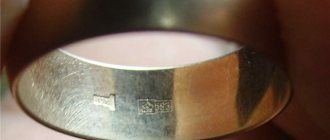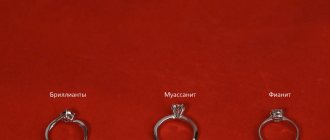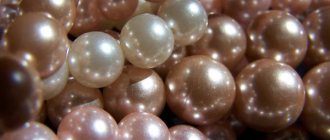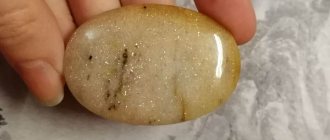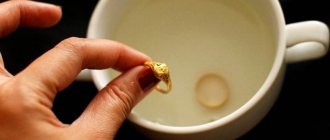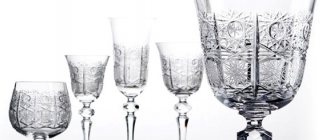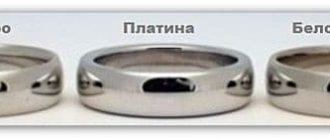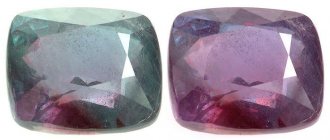Many people, before taking their gold to a pawnshop or repair shop, think about how to find out the weight of gold at home so that they cannot be deceived in the future. Unfortunately, there are times when you have to go to a pawnshop or the gold item breaks or bends and needs to be sent in for repairs in order to be able to wear it again.
Also, there are people who mine gold on their own or collectors who like to collect gold trinkets. And, naturally, they want to know the weight of the mined gold, but, unfortunately, not everyone has home scales.
There is also a category of people who also want to weigh gold at home - these are females. When a young man gives them gold items, their curiosity wins, and they try in every way to find out the weight of the gold in order to determine the value of the jewelry.
There are many deceivers in the modern world, so everyone who has to go to a gold collection point worries about their product and is looking for ways to find out the weight of gold at home.
You can, of course, buy special scales, but in order to use them once you will have to pay a decent amount, so it is better to try to find out the weight of gold without them. They are expensive because of the built-in mechanism that gives the exact weight of the product. Of course, for those who have started gold mining or collecting, they cannot do without scales and will have to spend a lot of money.
How to find out the mass of a product without a scale?
Using a tablespoon
- 50: jam, butter;
- 30: starch, honey, flour, salt, ground nuts;
- 25: sour cream, cocoa powder, rolled oats, sugar, semolina, buckwheat, pearl barley, millet, rice, millet, granulated sugar, soda;
- 20: milk powder, sugar, milk, ghee, vegetable oil, tomato juice, water;
- 18: any liquid;
Interesting materials:
What is the advantage of the base coating over other coatings? What is the advantage of a Parker pen? What is the cause and what are the consequences of the greenhouse effect? What is the cause of a short circuit and what does it lead to? What is the reason for the change in the direction of natural zones from latitudinal to meridional? What is the cause of solar and lunar eclipses? What is genius? What is the difference between metaphor and metonymy? What does AgBr dissolve in? What is the difference between horsetails and mosses?
How to weigh gold using improvised means?
07.06.2021
There are several options for weighing gold at home. The most obvious thing is to purchase electronic scales that show the result with nanogram accuracy. But such an accurate measuring device is not always at hand, and the answer needs to be obtained in a short time, albeit approximately. And there may be several reasons for this need:
- Often necessary for those who make solder: it is created by mixing several metals, the dosage of which must be calculated carefully.
- Pawnshop workers check the quality of products. As a rule, they have accurate equipment, but it may break down or not be available at the right time.
- People involved in gold mining also figure out how and where to weigh the gold, because usually miners' teams are located far from populated areas.
If you need to constantly determine the weight of a product, then you should buy jewelry scales. But if such a situation is isolated, then you can turn to home methods.
How to weigh gold at home: 2 reliable ways
If you know the composition of gold, remember your school physics course and use Archimedes' law. To do this, you need to pour water into any small container to the brim, placing it in the pan. Then put the item to be weighed into it. It is convenient to measure the volume of spilled water with an insulin syringe. Next, simple mathematics comes into force: we multiply the volume of displaced water by the density of the metal, and we get its weight.
Here's a little hint on the density of metals, depending on the sample:
- pure gold – 19.3 g/m3,
- 585 sample (with a reddish tint) – 13.2 g/m3,
- white gold – 12.8 g/m3,
- green – 14.3 g/m3.
You can also weigh gold without scales using the balancing method. To do this you need:
- Take a small, flat stick that will not bend.
- Tie threads to its middle and ends so that they hang freely.
- Tie small but identical containers to the threads on both sides of the stick.
It is best to use USSR coins, since their denomination corresponds to their weight. But if you don’t have these at hand, use modern Ukrainian coins:
- 1 kopeck – 1.5 g.,
- 2 kopecks - until 20001 - 0.64 g, from 2001 - 1.8 g,
- 5 kopecks – 4.3 g.,
- 10 kopecks – 1.7 g.,
- 25 kopecks – 2.9 g.,
- 50 kopecks – 4.2 g.,
- 1 UAH – 7.1 g.
To use this method, balance your improvised scales. For these purposes, place identical coins in both containers along the edges, and move the thread in the center along the axis until the stick is strictly along the ground. After this, you can determine the mass of the product using a set of coins of different sizes.
If you use fairly new coins that have not been worn out, then you can weigh jewelry coins in this way quite accurately. By combining different options, you can get results accurate to tens of a gram, if you pay attention to balancing the “scales”: the stick should always be parallel to the ground.
Indicators of the specific gravity of other metals
Specific gravity is an indicator that is an integral characteristic of other metals.
The specific gravity of silver is affected by the fineness of the alloy. When other metals (copper, nickel) are added to it, the specific gravity and density are lost. Thus, the density of copper is 8.93 g/cm3, nickel – 8.91 g/cm3. All values are calculated using formulas.
You may be interested in: What does it mean if you dreamed of a gold chain?
Silver is the same noble metal as gold. Its specific gravity is 10.5 g/cm3. It melts at a temperature of 960 degrees. The main physical characteristics of silver are:
- corrosion resistance;
- low resistance;
- increased light reflectivity.
Properties of silver
Among the physical properties of silver are:
- Increased resistance to corrosion. This makes it possible to use silver in situations with high humidity.
- Low resistance. A property that allows current to be transmitted quickly and without loss of electrons. Therefore, the precious metal is included in relays, microcircuits, and batteries.
- High light reflectivity - up to 95%.
Silver reacts only with sulfur and concentrated hydrochloric acid in a heated state. The metal itself is soft, but its specific gravity is heavy.
Caratage and the formula for calculating it
Among Western jewelers and scrap buyers of precious metals, the term “caratage” is common, denoted when marking products or bars with a large letter “K”. It should immediately be noted that it should not be confused with logging - a term that has a place among those who extract gold or lead in mines, mines, and quarries. Pure gold has a specific gravity of 24 carats. If you pay attention to the marking, it will be designated as “24K”. The categories of this metal are divided in the tables of buyers and jewelers from 8K to 24K, or from the smallest specific gravity to the largest.
Caratage for pure gold can also be expressed in decimal form and will be 0.999 purity. In this case, it is calculated by a simple formula, where the division of the actual caratage in pure gold is applicable. For an additional example, you can name another value, for example, in “14K”, which in decimal measurement is 0.583 (according to the formula: 14/24 = 0.583). For the same lead, this formula cannot be used.
There is a small exception, namely a feature associated with the most common gold markings. For 14k gold, the table below uses the 14K (14 karat) marking. However, the example above states that 14K gold is actually 0.583 purity. Nevertheless, the 585 standard is also marked with 14 carats. The same applies to 417 (10K) and 917 (22K). The rest of the list is self-explanatory: the sample number is in the left column of the table and the corresponding caratage is in the right.
Ratio of different official international samples
| Table of common gold markings | |
| 333 | 8K |
| 375 | 9K |
| 416 or 417 | 10K |
| 500 | 12K |
| 583 or 585 | 14K |
| 750 | 18K |
| 916 or 917 | 22K |
| 999 | 24K |
Dependence of the weight of a gold product on its purity. Percentage calculation
The same volume of gold can have different weights, since this also depends on density. Each gold stamp has a certain density and therefore a certain weight. Density tables for various types of analysis:
| Purpose | Density in cm3 per gram |
| 999,9 | 19,32 |
| 750 | 15,38-15,45 |
| 585 | 12,85-13,24 |
| 375 | 11,54-11,56 |
| 500 | 10,49 |
| 583 | 12,85-14,76 |
| 916 | 17,59 |
| 958 | 18,5 |
This mark is minted in accordance with the GOST standard, and the Assay Office is responsible for verifying compliance with this standard. The numbers refer to the gold content: 750 hallmark contains 75% of the base metal, and 585 hallmark contains 58.5%. Jewelers do not disclose the percentage of alloy content.
Being in nature
Silver is 65th in abundance among the elements found in the earth's crust. It is the most common of precious metals. The silver content in the earth's crust is approximately 0.075 g per ton of rock. This figure is 20 times greater when compared with gold or platinum. Silver is found in different quantities in different places. Typically this value varies between 0.05−1 grams per ton.
But various geological processes can also occur that increase the concentration of white metal to 1 kg per ton of rock. For example, there is a deposit called “Goltsovoye”. It is located in the Magadan region. In this mine, the concentration of silver reaches 1.2 kg per ton.
The precious metal can also be found in sea water, where its amount is an order of magnitude higher than gold. On average, this value is 0.00004 g per cubic meter.
The chemical activity of the material makes it quite difficult to find in its pure form. But there have been cases in history when people found truly huge nuggets. In 1894, the largest piece of silver was found in Colorado, which weighed 1065 kg. After melting, it was possible to obtain 835 kg of pure substance. Today it would be worth more than half a million US dollars.
There are almost 60 minerals in nature that contain silver. Often this element is included in sulfide ores of zinc, antimony, bismuth, copper and lead. Also, metal is always present in gold ores.
Quality check before purchase
In order not to fall into the seller’s trap and not give your money for a low-quality product, you must first check it. If you don’t know how to find out the hallmark of gold when purchasing, we recommend that you first pay attention to the mark (or lack thereof); it should be clear, without abrasions or traces of soldering. And in order not to stumble upon a fake, you should follow a couple of simple rules:
Now we can take a closer look at each rule. High-quality products can only be found in those institutions that professionally sell valuable items and have a positive reputation among buyers. It is quite possible that the cost of goods and services in such places will be significantly inflated, but in this case the client can be provided with all the necessary documentation confirming the high level of quality.
Ideally, when examining, it is recommended to determine the presence of the manufacturer's imprint, as well as the level of the sample. If the backing is made carefully and professionally, then this indicates that the manufacturer really knows his business.
Reviews:
I wanted to know how expensive the ring the young man gave me was worth. I followed your advice and was pleasantly surprised. I weighed it with a ruler. It reminded me of my physics class, which was very interesting. I didn't even know it was so easy to spot a fake.
When I needed money to buy a new iPhone, I decided to pawn my jewelry. To make sure of this, I decided to check the weight. I was afraid that they would cheat and pay less. Buying special scales is unprofitable, and these tips came in handy. I checked it using various methods for accuracy and went to pick it up. (I won't be deceived!) I bought a phone.
Great advice, some of which my father passed on to me as a child. He is an archaeologist and knows everything about precious metals.
Description of the noble metal. How can you determine its purity?
Gold is a group 11 element with atomic number 79 on the periodic table. This metal was first discovered by man due to its unusual, attractive color. Jewelry began to be made from it in Ancient Egypt, India and China. The solar metal is mentioned in ancient myths, the Bible and scriptures. This material is very malleable: from 1 g you can make a wire up to 2 km long.
Currently, the precious metal is used to make dishes, clothing, furniture, jewelry, interior decoration items, and is a product for investment and savings. Pure gold without any impurities does not exist in nature.
Once extracted, it is refined, but 0.01% of the other components remain.
To assess purity, world measurement systems were introduced: metric and carat. The first expresses the ratio of grams of pure metal per kilogram of object. The karat system expresses the number of parts of gold per 24 parts of the alloy. Correlation of world systems:
A few words about gold marking
Many people are familiar with this interesting fact: in terms of mass, a piece of the same lead can be slightly heavier than an ingot of gold, but it happens the other way around. It's all about the labeling. What do these combinations of numbers and letters mean? In fact, there is nothing complicated about this; you can easily understand the meaning of the markings of gold products.
On many exchanges, such concepts as “heavier means more expensive” are not always applicable, but during operations for the purchase of the same scrap gold, silver, copper or lead, it is impossible to do without it.


